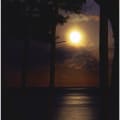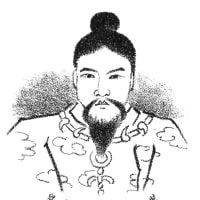古事記』應神天皇 9
又昔、有新羅國主之子、名謂天之日矛、是人參渡來也。所以參渡來者、新羅國有一沼、名謂阿具奴摩。自阿下四字以音。此沼之邊、一賤女晝寢、於是日耀如虹、指其陰上。亦有一賤夫、思異其狀、恒伺其女人之行。故是女人、自其晝寢時、妊身、生赤玉。爾其所伺賤夫、乞取其玉、恒裹著腰。此人營田於山谷之間、故耕人等之飮食、負一牛而入山谷之中、遇逢其國主之子・天之日矛。爾問其人曰「何汝、飮食負牛入山谷。汝必殺食是牛。」卽捕其人、將入獄囚、其人答曰「吾非殺牛。唯送田人之食耳。」然猶不赦。爾解其腰之玉、幣其國主之子。
故、赦其賤夫、將來其玉、置於床邊、卽化美麗孃子、仍婚爲嫡妻。爾其孃子、常設種種之珍味、恒食其夫。故其國主之子、心奢詈妻、其女人言「凡吾者、非應爲汝妻之女。將行吾祖之國。」卽竊乘小船、逃遁渡來、留于難波。此者坐難波之比賣碁曾社、謂阿加流比賣神者也。於是天之日矛、聞其妻遁、乃追渡來、將到難波之間、其渡之神、塞以不入。
故更還泊多遲摩國、卽留其國而、娶多遲摩之俣尾之女・名前津見、生子、多遲摩母呂須玖。此之子、多遲摩斐泥、此之子、多遲摩比那良岐、此之子、多遲麻毛理、次多遲摩比多訶、次淸日子。三柱。此淸日子、娶當摩之咩斐、生子、酢鹿之諸男、次妹菅竈上由良度美。此四字以音。
故、上云多遲摩比多訶、娶其姪・由良度美、生子、葛城之高額比賣命。此者息長帶比賣命之御祖。故其天之日矛持渡來物者、玉津寶云而、珠二貫・又振浪比禮比禮二字以音、下效此・切浪比禮・振風比禮・切風比禮、又奧津鏡・邊津鏡、幷八種也。此者伊豆志之八前大神也。
*「邊鏡」とは、古代日本において航海の安全を祈るために用いられた鏡のことです。読み方:へつかがみ。航海の安全を祈るために用いられた対になる鏡:奥鏡(おきつかがみ) 英訳: mirror for praying for the safety of navigation
(Perplexity)
≪英訳≫
There was a man named Ame no Hihoko (also known as Amanohiboko), the son of the king of Silla. This person came to Japan. The reason for his arrival was that in the country of Silla, there was a swamp called Agunuma(アグ沼). At the edge of this swamp, a lowly woman was taking a nap during the day. The sunlight shone upon her like a rainbow, and a lowly man, finding this sight suspicious, approached her to inquire about her condition. It turned out that she had become pregnant during her nap and had given birth to a red jewel.
The man who had inquired about the jewel took it and always wore it around his waist. Since he was cultivating fields in the mountains and valleys and had the oxen carry the food and drink of the farmers into the valleys, he encountered Ame no Hiho, the son of the king, there. The man asked him, ‘Why are you having the oxen carry food and drink into the valleys on their backs? You must be planning to kill the oxen and eat them.’ Attempting to capture the man and put him in a prison, Ame no Hihoko said, ‘You must be planning to kill these oxen. I will not allow it.’ Despite the man’s explanation that he was delivering food for the farmers, he was not pardoned.
Therefore, the man untied the jewel from around his waist and presented it to the king’s son. As a result, the man was pardoned. He placed the ball by the side of the bed. It became a beautiful maiden. Eventually, they got married, and she became his lawful wife. The maiden always made various delicacies and presented them to her husband. However, because the king’s son became arrogant and insulted his wife, she said, ‘I am not the kind of woman who should be your wife. I will return to my mother’s country.’ She secretly fled on a small boat to Naniwa. She was the goddess called Akaru Hime, who resided in the Himegoso Shrine in Naniwa.
Upon hearing about his wife’s escape, Ame no Hihoko pursued her to Naniwa, but he was unable to cross the sea as the sea god blocked his way. He returned to the country of Tajima, anchored his ship and stayed there and married a woman named Maetsumi, and had a son named Tadzimamorosuku. Tadzimamorosuku had a son named Tadzimahine, who had a son named Tadzimahinaraki.
The descendants continue through Tadzimamori, Tadzimahitaka, and Kiyohiko. Kiyohiko married Tagima no Mehi and had two children, Suganomorowo and Sugakamayuradomi. Among them, Tadzimahitaka, whom I mentioned earlier, married his cousin Yuradomi and had a daughter, Takanukahime of Katsuragi. She was the mother of Okinagatarashi Hime (Empress Jingū).
The treasures that Ame no Hihoko brought when he came to Japan were two jade strings called Tamatsuhō, as well as eight items: Neckcloth that calms the waves, Neckcloth that cuts the waves, Neckcloth that shakes the wind, Neckcloth that cuts the wind, Inner mirror, and Side mirror. All of these are enshrined in the Izushi Shrine.
*Note: “Side mirror” or “邊鏡(へつかがみ)” refers to a mirror used in ancient Japan to pray for safe navigation during voyages.
≪この英文の和訳≫
新羅(しらぎ)の国王の子である天日矛(あめのひほこ)という人物がいました。この方が日本に渡ってきました。その渡来の理由は、新羅の国にアグ沼と呼ばれる沼があり、その沼のほとりである賎しい女が昼寝をしていました。そこに太陽の光が虹のように差し込んだため、ある賎しい男がこれを怪しみ、その女の様子を尋ねました。すると、その女は昼寝の間に妊娠して、赤い玉を生みました。
この玉のことを尋ねた男がそれを受け取り、常に腰に巻きつけていました。この男は山谷で田畑を耕し、農夫たちの飲食物を牛に背負わせて山谷に運び入れる仕事をしていました。そこで国王の子である天日矛(アメノヒホコ)と出会いました。彼は男に尋ねました。「なぜ牛に飲食物を運ばせて山谷に入るのか。おそらくその牛を殺して食べるつもりだろう」と。そして、男を捕らえて牢に入れようとしましたが、男は「私は牛を殺すつもりはありません。単に農夫たちの食べ物を運んでいるだけです」と答えました。しかし、許されることはありませんでした。そこで男は腰に巻いていた玉を解き、国王の子に贈りました。それで男は許されました。玉を持つて来て床に置いていたら、美しい孃子(おとめ)になり、遂に結婚して正妻としました。
妻はいつも様々な珍味を作り、夫に進めました。しかし、国王の子は傲慢になり、妻を侮辱したため、彼女は「私はあなたの妻になるような女ではない。母の国に戻ろう」と言って、密かに小船に乗って難波(なにわ)に逃げました。この乙女は難波の比売御祖(ひめごそ)の社(やしろ)においでになるアカル姫という神です。
その後、天日矛(あめのひほこ)は妻の逃亡を聞き、彼女を追って難波に行こうとしましたが、海の神が海を遮りましたので、彼は難波には行けませんでした。それゆえに天日矛は更に但馬の国に船を停め、その国に滞在しました。但馬のマタヲの女のマヘツミと結婚して生うんだ子はタヂマモロスクです。その子がタヂマヒネ、その子がタヂマヒナラキ、その子は、タヂマモリ・タヂマヒタカ・キヨ彦の三人です。
このキヨ彦がタギマノメヒと結婚して生うんだ子がスガノモロヲとスガカマユラドミです。上に擧げたタヂマヒタカがその姪めいのユラドミと結婚して生んだ子が葛城のタカヌカ姫の命で、これがオキナガタラシ姫の命(神功皇后)の母君です。
天日矛が日本に持ち込んだ宝物は、玉糸で繋がれた玉である「玉通宝(たまつほう)」二本と、波を静める首巾(ひれ)、波を断つ首巾、風を断つ首巾、奥つ鏡、邊鏡(へつかがみ)の八つです。これらは出石(イヅシ)の社(やしろ)に祭られている八つ柱の神々です。
*「邊鏡」(へつかがみ)とは、古代日本において航海の安全を祈るために用いられた鏡のことです。
令和5年8月25日(金) 2023













